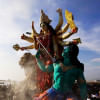Durga Puja, the annual Hindu festival also known as Sharadiya (autumnal) Durgotshob, is the worship of "Shakti", the divine force, embodied in Goddess Durga.
The fight between Goddess Durga and Mahishasura lasted for 10 days. The Goddess slayed the demon king on the 10th day, and the occasion is celebrated as Vijaya Dashami, symbolising the victory of good over evil.
Hindus believe that Durga descended to earth following prayers by King Kangsa. Marking the occasion, the first Durga worship was held at Taherpur of Rajshahi by Raja Kangshanarayan in the month of Aswin, around 1606.
Rama, the elder son of King Dasharatha, had earlier offered the puja in autumn to seek the deity's blessings to save people from the repression and misrule of Lanka Raj Ravana. With her blessings, Rama destroyed the Ravana's kingdom.
This year Mahalaya, which marks an invitation of sorts to goddess Durga to begin her journey from Kailash to her paternal home (earth), along with her children, falls on 2 October.
Mahalaya marks the beginning of Devi Paksha and the end of Pitru Paksha. On this day, the Hindu community pays homage to their ancestors by performing Tarpan or Shraddha rituals, intended to bring solace to their departed souls.
The day on which Goddess Durga arrives and departs is considered an omen. If Durga comes or departs on Monday or Sunday, the Goddess arrives and goes back on an elephant. If she comes or departs on a Saturday or Tuesday, she arrives and goes back on a horse. If Durga comes and departs on Thursday or Friday, her vehicle would be a palanquin and if she comes and departs on Wednesday, she arrives and goes back by boat.
This year Devi Paksha will begin on October 3. Hence, Navratri will also begin on October 3.
This year Durga will arrive on Thursday, 3 October. She will come on a palanquin and she will go back on Saturday, 12 October, by horse.
According to astrologers, the arrival of Goddess Durga in a palanquin is considered inauspicious. This signifies potential economic downturn, trade stagnation, increased violence, global pandemic spread and unnatural disasters. And as she will return by horse, it signifies social unrest, political incidents and natural calamities.
The author is a special correspondent at The Daily Star.









Comments